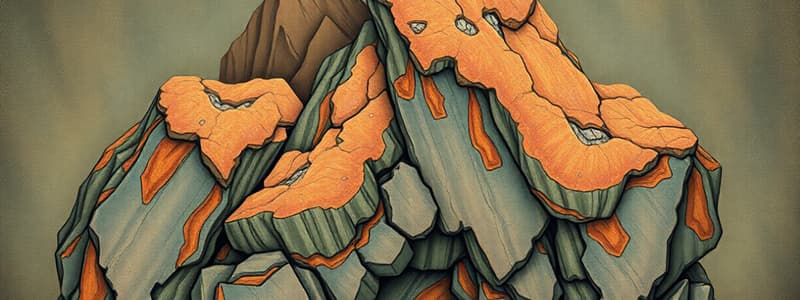Podcast
Questions and Answers
What characterizes extrusive igneous rocks compared to intrusive ones?
What characterizes extrusive igneous rocks compared to intrusive ones?
- Extrusive rocks form from cooled lava on the Earth's surface. (correct)
- Extrusive rocks typically contain large crystals.
- Extrusive rocks form from magma that cools slowly.
- Extrusive rocks form beneath the Earth's surface.
Which of the following statements about metamorphic rocks is true?
Which of the following statements about metamorphic rocks is true?
- Metamorphic rocks are formed from the cooling of magma.
- Metamorphic rocks can be created when existing rocks are subjected to heat and pressure. (correct)
- Metamorphic rocks retain the same properties as their parent rocks.
- Metamorphic rocks are only formed from igneous rocks.
Which rock type is an example of a metamorphic rock?
Which rock type is an example of a metamorphic rock?
- Granite
- Marble (correct)
- Obsidian
- Basalt
What indicates that a metamorphic rock has been subjected to intense heat and pressure?
What indicates that a metamorphic rock has been subjected to intense heat and pressure?
Which of the following statements about the crystal size in igneous rocks is correct?
Which of the following statements about the crystal size in igneous rocks is correct?
Flashcards are hidden until you start studying
Study Notes
Igneous Rocks
- Formed from the cooling of molten rock, either lava (on the surface) or magma (underground)
- Extrusive igneous rocks are formed from lava on the Earth's surface
- Intrusive igneous rocks are formed from magma that cools beneath the Earth's surface
- The rate of magma cooling influences crystal size:
- Slow cooling results in large crystals
- Fast cooling results in small crystals
- Examples of igneous rocks include granite and basalt
Metamorphic Rocks
- Formed from existing rocks (parent rocks) that have been transformed by heat and/or pressure deep within the Earth
- Heat and pressure cause the parent rock to react and change, creating a new rock with different properties
- Examples of metamorphic rocks include marble and slate
- Metamorphic rocks often have bands or layers due to the changes in mineral composition and alignment
- Schist typically exhibits layered bands
- Gneiss is characterized by distinct and often contrasting colored bands/layers
- The process of metamorphism increases the strength of rocks
- The properties of the metamorphic rock will be distinct from the parent rock
Studying That Suits You
Use AI to generate personalized quizzes and flashcards to suit your learning preferences.




